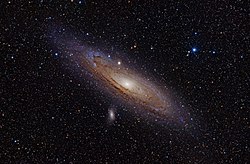Astronomy and space exploration

- November 23 – Edwin Hubble announces his discovery that Andromeda, previously believed to be a nebula, is actually another galaxy, and that the Milky Way is only one of many such galaxies in the universe. [1]
- The Einstein Tower near Potsdam, Germany, designed by Erich Mendelsohn, becomes operational as an astrophysical observatory.
- Mount Stromlo Observatory near Canberra, Australia, is established as the Commonwealth Solar Observatory.
- 1056 Azalea is discovered.